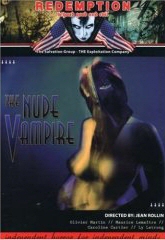
Jean Rollins is a celluloid poet whose sensuous flesh -scapes of death, desire, and derangement are at once both operatic and erotically intimate. Using as his canvas the paradoxical human fear of (and fascination with) sensuality and death, his films are beautiful ballets of pain and love. Rollins has proved true to his aesthetic inspiration throughout a decades-long fascination with vampirism. This obsession most often finds itself expressed in surrealistic images and dream-logic. Exchanging clean cut linear narratives for fragmented image-poems, his archetypal orgies of sin and skin prove as challenging as they are evocative. Coming after Le Viol Du Vampire, his experimental short, The Nude Vampire was Rollin's first feature length descent into the madness of desire. While largely ignored when released, this minor masterwork of deceit is both entertaining and historically important. In it Rollins is already examining key themes and images that would continue to inform his skewered storytelling. Featuring the misleading nature of perception, nude vampires, and decrepit architecture, this telling story of revelations and the power of love/sex to both liberate and destroy was a blueprint for the delirium to come.
When a young man (Oliver Martin) meets a mysterious, nearly nude young woman (Caroline Cartier) fleeing a mob wearing animal masks, his life is forever altered. When the woman is torn from his grasp, he tracks her down to a crowd of elegantly attired men and women standing in line near an overwhelming estate. Sneaking in, he is escorted to a room where a middle aged woman takes her life. A ritualistic evening of mystical perversion and debauchery ensues, wherein guests don blue hoods and watch as the young woman whom Martin was so very taken with proceeds to drink the suicidal woman's blood. When it becomes his turn to die, the young man, having assumed another man's identity, flees. He later learns that the suicide cult is headed by his own father and that the young woman is a vampire, unable to stand the sun and feeding on blood. As a race against time and desire begins, the young man learns that his father seeks to steal her power of everlasting life . . . but the secrets she holds come at a price.
When people think of Rollins, the images and thoughts that come quickest to mind are those of paradoxical beauty and decay: swirling fog banks, grand gothic torture chambers and elegant antiquity; rolling surfs and the gloomy eternity of deserted beaches at the end of the world; heaving flesh, women both dangerous and desirable, and blood. These are bound to -- and contribute to -- the larger key figure and theme of vampire, that first, true love of the director. Yet the term vampire, and the narrow manner in which it has long been interpreted by critics and fans, does both the director and his fascination a disservice. For the vampires in Rollin's vision are often as much victims as victimizers, and they aren't only more sympathetic than the traditional Hammer or Universal bogey but more believable. At the same time, his take on vampirism is more complex and philosophically inspired than the majority of mainstream muck crowding screens and video shelves. The Nude Vampire already exhibit's the director's understanding of the ambiguous nature of love and desire, as well as his use of moral ambiguity to further enrich his expressionistic plots. The protagonist's father (and the cult he represents) are every bit as much vampires as the one they hold in captivity, and the already thin line between predator and prey, right and wrong, is deliciously eroded. Vampirism here is depicted in its most universal definition, milked for tragedy, mystery, and social condemnation -- all of which are injected with vigor and wonder by Rollin's use of color and atmosphere. The structure of the narrative is bold, and its non-linear orgy of fragmented narrative and disassociated imagery mirrors the ambiguity of motive that lies at the story's dark heart. An unrepentant fantasy, Rollins is more concerned with sensation and emotional overload than with definition. The film comes across with the emotionally intense illogic of a dream, intellectually nonsensical but meaningful on an instinctive plane. No means a total triumph, dialogue is stilted, and the story lags in several places. Still, there is enough suggestive menace and outrageous imagery to make up for this shortcoming, and the touches of science fiction and kink point dramatically to the dreams of surrender and destruction that Rollins had up his sleeves.
Salvation Films releases The Nude Vampire through its decadent Redemption USA banner, and while this appears to be the English version, missing some scenes, everything of real worth is included. The print is clean for the most part, featured in 1.66:1 widescreen (non-anamorphic). Although grain occasionally appears, colors are bold and vibrant, lending vibrancy to the bizarre. Audio is less even, with dialogue a bit on the soft side and sound effects/score very loud.
Extras are an exciting bag, including Rollin's first cinematic experiment, Les Amours Jaunes. Also known as The Yellow Loves, this film can be seen as a reference point -- a breeding ground for many of the director's obsessive themes and visual style. Already we see Rollins disregarding traditional narrative structure, going for surrealistic visual 'dream' sense -- an instinctive form of understanding -- rather than pure logic. Focusing on the director's preferred coastlines, scenes of cliffs and wind-swept nature are merged with drawings, all coated with dialogue of a man reading a poem by Tristan Corbiere. Visually speaking, the short is marred by scratches but this is forgivable considering the rarity of the item. Audio is featured in short in French with English subs. Other extras include original French and English Theatrical Trailers, Still Galleries for both the feature and the short, and previews of other films.
Review by William Simmons
| Released by Redemption USA |
| Region 1 - NTSC |
| Not Rated |
| Extras : |
| see main review |